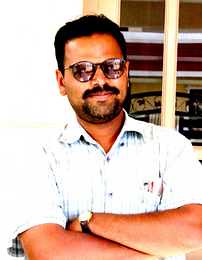Bad news about bird 'n' bees
ALLADI JAYASRI
It was the eye-catching invite that clinched the matter with its brain-teasing bit of photography. Shutterbug Sandesh V. Kadur's handsome coffee table book, Sahyadris: India's Western Ghats — A Vanishing Heritage, was going to be as captivating as the cover, the invite promised. The invite showed a bit of tiger skin, stripes and all, some interesting bits of rock, rows ferns, and finally something that looked like a sinful slab of chocolate chip ice-cream.

What's this, I asked. Take a guess, he said with a twinkle in his eye that said: "I'm sure you've no clue." But this was all about wildlife, and an inspired guess: "I know! It's the cobra's hood in extreme close-up!" turned the challenge into admiration, and the heavy tome was pushed forward. Sahyadris, which Sandesh has co-authored with Kamal Bawa, is indeed awesome. The cover, featuring a blanket of fog over a valley in Kerala's Eravikulam National Park, enchants instantly, and starts you off on an inexorable journey into the wonders of the Western Ghats.
It's a powerful book too. The photographs, all by Sandesh, were taken when he was filming a documentary for Gorgas Science Foundation (GSF), Brownsville, Texas, and three years ago. Flipping through the book, the awesome truth hits you — roughly 40 per cent of the flora and fauna found in the Western Ghats may exist nowhere else on earth.
The book had the president of GSF exclaiming that he ought to be back soon to do one on Rio Grande.
A recent winner of the Infosys-EducationWorld Young Achievers Award 2005, Sandesh says his Sahyadris: Mountains of the Monsoon was a four-year labour of love. It won him a slew of international awards — the prestigious Gold REMI award for creative excellence (Houston World Fest 2003), a merit award for cinematography at the International Wildlife Film Festival (2002) and a special jury award for wildlife conservation at the Vatavaran Film Festival held in New Delhi in 2003. Sahyadris was also nominated for a Green Oscar award in 2002.
Kadur's passion for environmental causes, manifested in this 110-minute documentary film on the Western Ghats — which flashes brilliant images of the world-famous Niligiri thar, a troupe of rare lion-tailed macaques, a tiger at a waterhole and nesting Great Hornbills — began while he was a biology undergrad at the University of Texas, Brownsville. Located in the Rio Grande Valley, Brownsville straddles the US-Mexico border and is well known for its rich flora and fauna.
"While in college I spent several days trekking, photographing and documenting the cloud forests of Mexico. Aware of my growing interest in nature and conservation, my professor, Lawrence Lof, asked me to produce a short wildlife documentary as part of my college summer holiday project. I felt that the Western Ghats, where as a teenager I had spent several weeks trekking and exploring, was the best location. A four-month summer project transformed into a four-year learning process during which I taught myself to film, photograph, edit, and script documentaries. In the end — thanks to the help and support of my professors — I had a graduate degree and a documentary to my credit," recalls Kadur, whose first attempt to capture his romance with the Western Ghats on film, was financed and supported by the Gorgas Science Foundation (estb.1948), a Brownsville-based education and conservation non-profit organisation.
Familiarity with a designated `biodiversity hotspot' — a region with incredibly high amounts of biodiversity which has lost over 70 per cent of its natural habitat — Kadur's summer project has converted him into a crusader for saving the Western Ghats.
Ironically this winner of the Infosys-EducationWorld Young Achievers Award 2005 is a dropout from National College, Bangalore, whose admission into the University of Texas, Brownsville, without a Class XII certificate, he credits to a miraculous "technical loophole". "I would have never made it to university if I had remained in India. Our higher education system is too rigorous and rigid. It doesn't allow for any creativity or innovation."
The co-author, Kamal Bawa, is a Distinguished Professor at the University of Massachusetts and founder of the Ashoka Trust for Research in Ecology and the Environment which is devoted to research, education and action in conservation in India.
The book is being released today by Infosys CEO Nandan Nilekani at the Taj Residency at 4.30 p.m. For copies, contact ATREE on 23533942 or ramesh@atree.org









0 Comments:
Post a Comment
<< Home